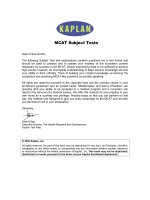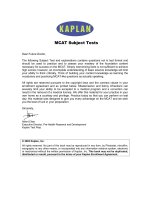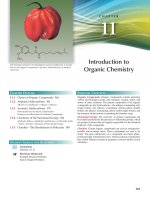General chemistry
Bạn đang xem bản rút gọn của tài liệu. Xem và tải ngay bản đầy đủ của tài liệu tại đây (7.47 MB, 226 trang )
www.pdfgrip.com
GENERAL CHEMISTRY
www.pdfgrip.com
www.pdfgrip.com
GENERAL CHEMISTRY
Rainer Roldan Fiscal
ARCLER
P
r
e
s
s
www.arclerpress.com
www.pdfgrip.com
General Chemistry
Rainer Roldan Fiscal
Arcler Press
2010 Winston Park Drive,
2nd Floor
Oakville, ON L6H 5R7
Canada
www.arclerpress.com
Tel: 001-289-291-7705
001-905-616-2116
Fax: 001-289-291-7601
Email:
e-book Edition 2020
ISBN: 978-1-77407-404-6 (e-book)
This book contains information obtained from highly regarded resources. Reprinted material
sources are indicated and copyright remains with the original owners. Copyright for images and
other graphics remains with the original owners as indicated. A Wide variety of references are
listed. Reasonable efforts have been made to publish reliable data. Authors or Editors or Publishers are not responsible for the accuracy of the information in the published chapters or consequences of their use. The publisher assumes no responsibility for any damage or grievance to the
persons or property arising out of the use of any materials, instructions, methods or thoughts in
the book. The authors or editors and the publisher have attempted to trace the copyright holders
of all material reproduced in this publication and apologize to copyright holders if permission has
not been obtained. If any copyright holder has not been acknowledged, please write to us so we
may rectify.
Notice: Registered trademark of products or corporate names are used only for explanation and
identification without intent of infringement.
© 2020 Arcler Press
ISBN: 978-1-77407-308-7 (Softcover)
Arcler Press publishes wide variety of books and eBooks. For more information about
Arcler Press and its products, visit our website at www.arclerpress.com
www.pdfgrip.com
ABOUT THE AUTHOR
Rainer Roldan Fiscal is an Associate Professor in Laguna State Polytechnic
University, Philippines and Research Coordinator of the College of Teacher
Education. He finished Bachelor of Secondary Education major in General
Science, Master of Arts in Teaching major in Science and Technology and
Doctor of Philosophy in Education major in Educational Leadership and
Management. He teaches Biological and Physical Science subjects, Professional
Education subjects and Methods of Research in the undergraduate and graduate
programs. He presented his papers in national and international conferences in
the Philippines and abroad. He published his papers in international journals.
www.pdfgrip.com
www.pdfgrip.com
TABLE OF CONTENTS
List of Figures ........................................................................................................xi
List of Tables .......................................................................................................xiii
List of Abbreviations ............................................................................................xv
Preface........................................................................ ......................................xvii
Chapter 1
Introduction to Chemistry ......................................................................... 1
1.1. What Is Chemistry? ............................................................................ 2
1.2. Applications Of Chemistry In Day-To-Day Life ................................... 5
1.3. General Chemistry ............................................................................ 11
1.4. Branches Of Chemistry ..................................................................... 13
1.5. Other Branches ................................................................................. 20
Review Questions .................................................................................... 27
References ............................................................................................... 28
Chapter 2
Periodic Table and Atomic Properties ..................................................... 29
2.1. An Introduction To Atomic Properties ................................................ 30
2.2. Early Attempts Made To Classify Elements ........................................ 30
2.3. Modern Periodic Table ...................................................................... 35
2.4. Structural Features of Long Form of The Periodic Table ..................... 37
2.5. Position of Metals, Non-Metals, And Metalloids ................................ 38
2.6. Categorization of Elements Into s, p, d, and f Block .......................... 39
2.8. Electronegativity ............................................................................... 49
Review Questions .................................................................................... 52
References ............................................................................................... 53
Chapter 3
Solutions And Properties of Solutions ..................................................... 55
3.1. An Introduction To Solution .............................................................. 56
3.2. Solubility And Equilibrium In Solution .............................................. 57
3.3. Re-Crystallization or Fractional Crystallization .................................. 58
www.pdfgrip.com
3.4. Ionic Compounds And Formation of Solutions .................................. 61
3.5. Major Factors Influencing Solubility .................................................. 63
3.6. Ideal And Non-Ideal Solutions .......................................................... 65
3.7. Raoult’s Law: The Vapor Pressure Of Solutions .................................. 68
3.8. Colligative Properties ........................................................................ 70
3.9. Colloids ............................................................................................ 74
Review Questions .................................................................................... 76
References ............................................................................................... 78
Chapter 4
Acids, Bases, And Salts ............................................................................ 79
4.1. Introduction ...................................................................................... 80
4.2. Arrhenius Acid-Base Theory .............................................................. 81
4.3. Bronsted-Lowry Acid-Base Theory..................................................... 82
4.4. Chemical Properties Of Acids And Bases ......................................... 85
4.5. pH Scale ........................................................................................... 88
4.6. Salts .................................................................................................. 92
4.7. pH of Salts ........................................................................................ 95
Review Questions .................................................................................. 106
References ............................................................................................. 107
Chapter 5
The States Of Matter ............................................................................. 109
5.1. Introduction .................................................................................... 110
5.2. Intermolecular Forces .................................................................... 113
5.3. Thermal Energy .............................................................................. 116
5.4. Intermolecular Forces vs. Thermal Interactions ............................... 116
5.5. Transition of States of Matter ........................................................... 119
5.6. The Kinetic Molecular Theory of Matter .......................................... 120
5.7. The Charles’ Law ............................................................................ 123
5.8. Vapor Pressure ............................................................................... 125
Review Questions .................................................................................. 128
References ............................................................................................. 129
Chapter 6
Chemical Bonding ................................................................................. 131
6.1. Introduction .................................................................................... 132
6.2. The History Behind The Bonding ..................................................... 133
viii
www.pdfgrip.com
6.3. Types Of Chemical Bonding............................................................ 137
6.4. Lewis Symbols ................................................................................ 143
Review Questions .................................................................................. 147
References ............................................................................................. 148
Chapter 7
Electrochemistry ................................................................................... 149
7.1. Introduction .................................................................................... 150
7.2. Electrochemical Microsystem Technology ....................................... 151
7.3. The Fundamentals of Electrochemistry ............................................ 154
7.4. Electrolysis And Electrochemical Cell ............................................. 155
7.5. Electrolysis of Sodium Chloride ...................................................... 159
7.6. Electrolysis of Water ....................................................................... 162
7.7. Applications of Electrolysis ............................................................. 166
Review Questions .................................................................................. 171
References ............................................................................................. 172
Chapter 8
The Units of Measurements................................................................... 173
8.1. Introduction .................................................................................... 174
8.2. Scientific Units The SI And Metric Units .......................................... 175
8.3. History of The SI System.................................................................. 176
8.4. The Units of Measurements ............................................................. 179
8.5. International System of Units and The Metric System ...................... 182
8.6. Metric System vs. “English System” ................................................. 192
8.7. The Importance of Measurement ..................................................... 195
Review Questions .................................................................................. 199
References ............................................................................................. 200
Index ..................................................................................................... 201
ix
www.pdfgrip.com
www.pdfgrip.com
LIST OF FIGURES
Figure 1.1: Chemistry: the study of matter
Figure 1.2: The Bohr-Rutherford atomic model
Figure 1.3: Branches of chemistry
Figure 1.4: Analytical chemistry
Figure 1.5: Green Chemistry
Figure 2.1: Dobereiner’s triad
Figure 2.2: Newland’s law of octaves
Figure 2.3: Periodic table
Figure 2.4: Ionization enthalpy
Figure 2.5: Electronegativity
Figure 3.1: Chemical solutions
Figure 3.2: Recrystallization
Figure 3.3: Different types of solvent-solute interactions
Figure 3.4: A comparison between ideal and non-ideal solution
Figure 3.5: Positive and negative deviations from Raoult’s law
Figure 3.6: Osmotic pressure
Figure 4.1: Arrhenius acid-base theory
Figure 4.2: Bronsted-Lowry acid-base reaction
Figure 4.3: Definition of olfactory indicator
Figure 4.4: pH scale
Figure 4.5: Classification of salts
Figure 5.1: States of matter
Figure 5.2: Intermolecular forces
Figure 5.3: Thermal energy
Figure 5.4: Boyle’s law
Figure 5.5: The volume of a gas increases as the Kelvin temperature increases.
xi
www.pdfgrip.com
Figure 6.1: Polar covalent bonds in a water molecule
Figure 6.2: Types of chemical bonding
Figure 6.3: Lewis Dot Symbols for the Elements in Period 2
Figure 7.1: Bipolar electrochemistry
Figure 7.2: Electrochemical microsystem technology
Figure 7.3: Electrolysis
Figure 7.4: Electrolysis of water
Figure 8.1: Unit conversions
Figure 8.2: International System of Units
Figure 8.3: English system of measurement
Figure 8.4: Importance of measurement
xii
www.pdfgrip.com
LIST OF TABLES
Table 2.1: Electronic Configuration of Li, Na, and K
Table 3.1: Types of Solutions depending upon the state of solvent and solute
Table 3.2: Different energy terms of different solvents and solutes
Table 3.3: Solvents and their melting and boiling points
Table 3.4: Colloidal Particles and their state of medium
Table 4.1: Naturally occurring acids
Table 4.2: Indicators and their acidic and basic forms
Table 5.1: The temperature-volume data
Table 8.1: Base units of the SI system
Table 8.2: Prefixes used with SI units
xiii
www.pdfgrip.com
www.pdfgrip.com
LIST OF ABBREVIATIONS
C
cathode
C2H5OH
ethanol
C3H6O
acetone
C6H14
hexane
C6H6
benzene
C7H16
heptane
C7H8
toluene
CH3OH
methanol
CHCl3
chloroform
CNIC
Commission on Nomenclature of Inorganic Chemistry
CS2
carbon disulfide
IMFs
intermolecular forces
IPK
international prototype kilogram
K
Kelvin
KE
kinetic energies
NaOH
sodium hydroxide
NH3
ammonia
OH–
hydroxide ion
SI
System of Units
www.pdfgrip.com
www.pdfgrip.com
PREFACE
Chemistry has been a subject that has helped in the evolution of humans in a
manner that very few of the other subjects have. Chemistry finds its applications
across verticals such as food, medical, manufacturing, and other crucial aspects
on which the humans depend for existence.
Chemistry as a subject is taught to students so that they know about the basics
of chemistry in case they encounter any regular problem of reference to the
chemicals, say in case of salts in a medicine.
At higher levels of the study and teaching of chemistry, other information
comes in like the kinds in which chemistry is divided, the reactions and the
product that they give, the chemistry of physical occurrences of chemicals and
compounds and other such areas of concern.
This book brings the focus of the readers to the topics that cover almost all
aspects related to chemistry so that they get a complete idea of chemistry in a
short composition. The book introduces the general form of chemistry to them,
which might be valuable in explaining all the basics of chemistry to the readers
in an appropriate way.
The book explains the readers about the relation that chemistry holds with other
sciences. The readers should know the reason behind any subject they want to
read and the relevance it holds in the physical world. This will help them have
an interest in the subject and feel more connected with it.
The book also discusses the different kinds of chemistry and what each kind
deals in. All the elements in chemistry are depicted in a tabular form that is
commonly known as the periodic tables. The placing of each element that
is found on earth has been done very thoughtfully so as to organize all the
elements in several categories and classify them to study about their physical or
chemical occurrence.
The book explains the periodic table in detail to the readers so that they are
absolutely clear with the basics of the periodic table. It also informs the readers
about the development of the periodic table and the history it holds with regard
to the manner in which the elements have had been added to the table.
www.pdfgrip.com
There is a special significance that solutions hold in chemistry. It explains the
various states in which the solutions can be found and the concept of equilibrium
in the solutions. The readers are informed about the energy that is produced in
the formation of a solution.
The book also focuses on the various parameters that decide the solubility of
solutions and the bonds that are formed in order to form a solution. It also
explains the meaning of ideal and non-ideal solutions and the relevance they
hold.
The book further moves to introduce the topics of salts, bases, and acids. The
readers are explained about each of them. The book explains the readers about
their occurrence, formation, importance, uses, and all other aspects related to
them. It also informs them about some of the most commonly used compounds
and what they are according to the classification, so that readers get a first-hand
experience of the relevance of all three kinds.
The readers are informed about the process of bonding in chemistry. The book
informs them about the different kinds of bonds that exist between various
elements in a compound and explains them about the formation of all the kinds
of bonds. The book also tells them about the significance of each kind of bond.
The book moves further to discuss the process of electrolysis and informs the
readers about various ways in which it can be done and can prove beneficial to
the chemical evolution. This it tells the readers about the process of extraction
of ions and other such processes.
The book then elaborates on the various units of measurement in the subject of
chemistry. It focuses on the SI units and the various conventional and traditional
units of measurement, their inter-conversion, and their readability and the
manner in which they can be interpreted.
xviii
www.pdfgrip.com
CHAPTER
1
INTRODUCTION
TO CHEMISTRY
LEARNING OBJECTIVES:
In this chapter, you will learn about:
•
The definition of chemistry
•
Various applications of chemistry
•
Stoichiometry: elementary atomic theory and chemical kinetics
•
Different branches of chemistry
KEYWORDS
•
•
•
Organic Chemistry
Stoichiometry
Inorganic Chemistry
•
•
•
•
•
www.pdfgrip.com
Physical Chemistry
Analytical Chemistry
Green Chemistry
Biochemistry
Immunochemistry
2
General Chemistry
1.1. WHAT IS CHEMISTRY?
The scientific study of matter (anything that occupies space and has
mass), its features and interactions with energy and other matter is
called chemistry. Chemistry can also define as the science that involve
the systematic study of properties, composition, various elementary
forms of matter, and activity of inorganic and organic substances.
Science is the identification, experimental investigation, observation,
description and theoretical explanation of natural phenomena.”
Figure 1.1: Chemistry: the study of matter.
Source:
html
/>
1.1.1. Relation of Chemistry with Other Sciences
It is important to note that chemistry is a science that indicates its
methodologies are reproducible and systematic and its theories are
examined using scientific methods. The scientists who study chemistry
are called chemists.
Chemists are not only responsible for examining the interactions
between the substances but also are responsible for studying the
properties of matter and their composition. Chemistry is closely
connected to biology and physics. Chemistry as well as physics both
falls under the category of physical sciences. In fact, according to some
www.pdfgrip.com
Introduction to Chemistry
3
scripts the definition of physics and chemistry
is entirely the same. Like in other sciences, for
the study of chemistry also mathematics plays a
vital role.
1.1.2. Need to Study Chemistry
Many people search ways to avoid chemistry or
are scared it or have chemistry phobia. This is
because it involves equations and math.
However, it is essential for an individual to
know the basic and general principles involved
in chemistry, whether you have to take a chemistry class for a grade or not. Chemistry is at the
heart of understanding everyday materials and
processes.
The study of chemistry helps the people to
understand the various phenomena that are going
on around them. It explain some processes such
as the reason behind the change in color of the
leaves in the season of fall, the appearance of
various kinds of plants, the preparation process
of cheese, the composition of soap and the main
reason behind why it is used to clean things. All
these things can be explained by the application
of chemistry.
Having acquaintance with the subject
of chemistry can enable people to read and
understand the text written on the bottles
regarding the use of substances in the product.
The knowledge of chemistry can help the people
in identifying whether some information given
about a particular product is true or it is some
scam that the advertisers are committing.
It enables them to take smart decision on
the actuality of a product being as effective as
www.pdfgrip.com
Chemistry is
the scientific
discipline involved
with elements
and compounds
composed of atoms,
molecules and ions:
their composition,
structure, properties,
behavior and the
changes they
undergo during a
reaction with other
substances.
4
General Chemistry
the advertisers of a product claim it to work and
will even modify the way the people expect the
products to work. Chemistry can go on to make
a person a good cook or a chef.
If the person knows about the way the
reactions take place while the food is being
cooked, they may be able to bake in a better
manner or may even be able to alter the texture
of food and its supplements according to the
way they want.
The knowledge of the various chemicals
can help the people to be secure when they
are handling some product at their homes. The
familiarity with chemistry will enable them to
know about the chemicals that can be harmful to
them if they come in some kind of contact with
them. So, the people would know how to handle
a product that contains a particular chemical in
it.
Chemistry can help the people acquire some
good reasoning skills as its study that involves
solving a lot of problems that come in its way
and tries to give reason for a process to occur.
Hence, it helps the people to find the reason
behind some events that may be taking place
simultaneously in the world, like the rise in
the prices of petroleum products, recalling of
some products by a company, the scenario of
pollution, the innovations taking place in the
technologies and the environment and so forth.
The study of chemistry equips the students
and others with the knowledge that they may use
to find the suitable career paths for themselves.
There are several jobs in the industry that require
the knowledge of chemistry and the industries
may include anything from food industry,
www.pdfgrip.com
Introduction to Chemistry
transportation, homemaking, art, retail stores
and others.
Last but not the least, chemistry has
numerous ways to amaze the people with the
reactions and other processes such as things
glowing in dark, change of states or formation
of bubbles and fountains.
1.2. APPLICATIONS OF CHEMISTRY IN DAY-TO-DAY LIFE
Have you ever wondered why chemistry is so
important? Why do we study chemistry?
All the things surrounding us, including us, are
made up of chemicals. Everything we see, taste,
smell, touch and hear is inclusive of chemicals
(matter) and chemistry. Seeing, touching,
hearing and tasting all involve intricate series of
chemical reactions and interactions in our body.
Most of the changes we see around us in the
world occur as a result of chemical reactions.
Chemistry is not confined to just laboratories
and beakers but is all around us. The more we
know the chemistry, the better we know our
world. Chemistry is observed in every aspect
of life. Some examples from our daily life are
listed below:
Sky appears blue
Color of an object is seen as a result of the light
that it reflects. Sun is source of white light. It
comprises of all the wavelengths. When this
white light coming from the sun falls on an object,
some of the wavelengths get reflected and some
are otherwise absorbed. The sky’s color is based
on the phenomena called Rayleigh scattering
www.pdfgrip.com
5









